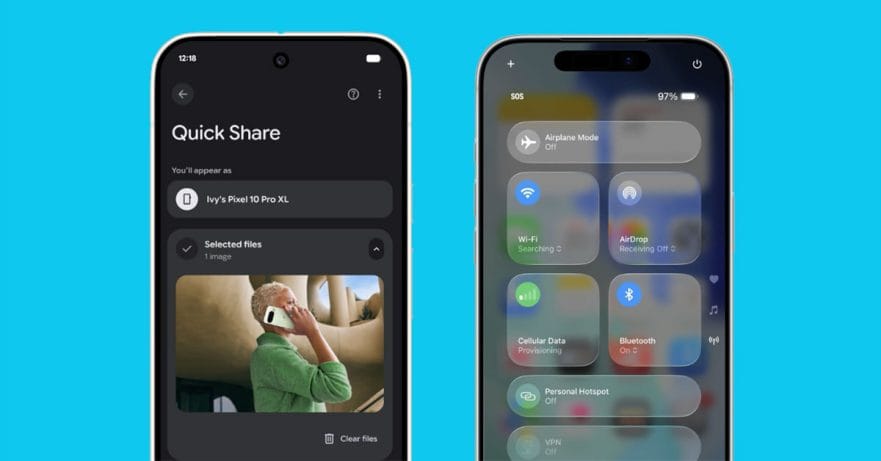If you live in a mixed-gadget household — and statistically most of us do — you know the specific agony of trying to send a high-res video from an Android phone to an iPhone. It usually involves email compression hell, a third-party app that feels sketchy, or the dreaded WhatsApp compression.
But today, Google did the impossible. The company didn’t just ask Apple to open the gate; it essentially picked the lock.
Starting with the newly released Pixel 10 family, Google’s Quick Share can now transfer files directly to AirDrop on iPhones, iPads, and Macs. It is, effectively, a massive flex of reverse-engineering that finally bridges the gap between the two mobile superpowers.
The green bubble wall is crumbling
According to Google’s official announcement, this feature is rolling out immediately to the Pixel 10 and Pixel 10 Pro. The premise is simple: “Sharing should just work.” And for the first time in smartphone history, it actually might, regardless of the logo on the back of your device.
Here is why this is a big deal: This is true peer-to-peer transfer. As reported by TechCrunch, the data isn’t routed through a cloud server. It’s a direct connection, meaning it works offline and maintains privacy. Google built this independently, without Apple’s help, by reverse-engineering the proprietary AWDL protocol that powers AirDrop.
Sharing moments shouldn’t depend on the phone you have. Starting today with the Pixel 10 family, Quick Share now works with AirDrop, making secure file transfers between Android phones and iPhones more seamless. This builds on our commitment to cross-OS compatibility to bridge… pic.twitter.com/iNdZfjCYQ7
— Android (@Android) November 20, 2025
Google’s announcement
It is also a strategic dagger from Mountain View. By launching this exclusively on the Pixel 10 series first, Google is creating a massive differentiator against Samsung and other Android heavyweights. If you want to be the person at the party who can send photos to everyone, you can’t buy a Galaxy just yet — you have to buy a Pixel.
Security was clearly the biggest hurdle in reverse-engineering a closed system. Google built the framework using Rust, a memory-safe language that the NSA and CISA currently cite as the industry benchmark. To prove it wasn’t just throwing code at the wall, Google brought in independent security experts from NetSPI for red-team penetration testing. The result? A system that Digital Trends confirms logs zero content and prevents the memory-related bugs that usually plague cross-platform hacks.
How to AirDrop from a Pixel 10
While the technology is impressive, the user experience still bows to Apple’s restrictions. Because Google is technically an uninvited guest in the AirDrop protocol, you can’t just beam files to an unsuspecting iPhone user; the person has to open the door first.
Here is how to make the magic happen:
- Prep the Apple device. Have your friend open his or her Control Center, long-press the network settings card, tap AirDrop, and select “Everyone for 10 Minutes.” (This is the current limitation of mimicking the protocol without official API access.)
- Send from Pixel. On your Pixel 10, select the file you want to share, tap Quick Share, and look for the Apple device. It should pop up just like any other Android phone.
- Accept the transfer. The iOS user will get a standard AirDrop prompt. Once they tap “Accept,” the file transfers over Wi-Fi Direct speeds.
It works the other way, too. If you want to receive files on your Pixel 10 from, say, an iPhone, you just need to set your Pixel to “Discoverable.” To the iPhone user, your Pixel just looks like another AirDrop target.
The future of the ecosystem
This move signals a massive shift. We are moving away from walled gardens toward a user-demanded open field. While Apple is busy planning enhanced security protocols for iOS 26, which may include 30-day access windows instead of the current 10-minute limit, Google has decided not to wait for an invite.
Google Android Ecosystem president Sameer Samat confirmed this tech will eventually expand to other Android devices, though there is no timeline for when your non-Pixel device will get the goods. For now, the Pixel 10 lineup is the only bridge across the OS divide.
It’s a bold, slightly rebellious move that proves interoperability is possible if you have enough engineering talent and the nerve to bypass your competitor’s permission slip. Your move, Apple.
Share this Post



